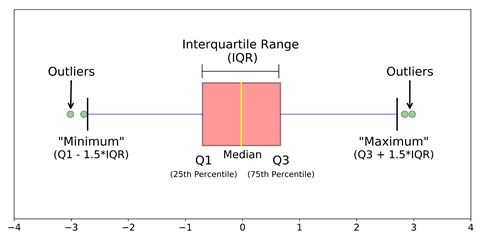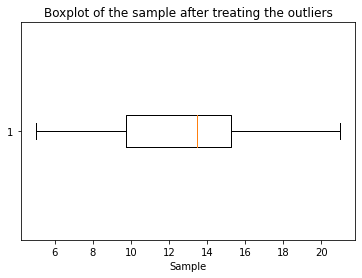One of the most important steps as part of data preprocessing is detecting and treating the outliers as they can negatively affect the statistical analysis and the training process of a machine learning algorithm resulting in lower accuracy. In this article, we will be discussing how to handle outliers! In this article majorly you will get understanding about how to handle outliers in machine learning and how these handle these outliers are performing so, you get in this article.

In this article, you will understand how to deal with outliers effectively, learn how to treat outliers in your data, and explore various methods for handling outliers to enhance your analysis.
This article was published as a part of the Data Science Blogathon.
We all have heard of the idiom ‘odd one out which means something unusual in comparison to the others in a group. Similarly, an Outlier is an observation in a given dataset that lies far from the rest of the observations. That means an outlier treatment is vastly larger or smaller than the remaining values in the set.
An outlier may occur due to the variability in the data, or due to experimental error/human error.
Quiz Time
Sharpen your knowledge of Detecting and Treating Outliers!
They may indicate an experimental error or heavy skewness in the data(heavy-tailed distribution).
In statistics, we have three measures of central tendency namely Mean, Median, and Mode. They help us describe the data.
Mean’ is the only measure of central tendency that is affected by the outlier treatment which in turn impacts Standard deviation.
Consider a small dataset, sample= [15, 101, 18, 7, 13, 16, 11, 21, 5, 15, 10, 9]. By looking at it, one can quickly say ‘101’ is an outlier that is much larger than the other values.
From the above calculations, we can clearly say the Mean is more affected than the Median.
If our dataset is small, we can detect the outlier by just looking at the dataset. But what if we have a huge dataset, how do we identify the outliers then? We need to use visualization and mathematical techniques.
Below are some of the techniques of detecting outliers
Python code for boxplot is:
Criteria: any data point whose Z-score falls out of 3rd standard deviation is an outlier treatment.

import numpy as np
outliers = []
def detect_outliers_zscore(data):
thres = 3
mean = np.mean(data)
std = np.std(data)
# print(mean, std)
for i in data:
z_score = (i-mean)/std
if (np.abs(z_score) > thres):
outliers.append(i)
return outliers# Driver code
sample_outliers = detect_outliers_zscore(sample)
print("Outliers from Z-scores method: ", sample_outliers)The above code outputs: Outliers from Z-scores method: [101]

Criteria: data points that lie 1.5 times of IQR above Q3 and below Q1 are outliers. This shows in detail about outlier treatment in Python.
outliers = []
def detect_outliers_iqr(data):
data = sorted(data)
q1 = np.percentile(data, 25)
q3 = np.percentile(data, 75)
# print(q1, q3)
IQR = q3-q1
lwr_bound = q1-(1.5*IQR)
upr_bound = q3+(1.5*IQR)
# print(lwr_bound, upr_bound)
for i in data:
if (i<lwr_bound or i>upr_bound):
outliers.append(i)
return outliers# Driver code
sample_outliers = detect_outliers_iqr(sample)
print("Outliers from IQR method: ", sample_outliers)The above code outputs: Outliers from IQR method: [101]
Till now we learned about detecting the outliers handling. The main question is how to deal with outliers?
Below are some of the methods of treating the outliers:
In this technique, we remove the outliers from the dataset. Although it is not a good practice to follow.
Python code to delete the outlier treatment and copy the rest of the elements to another array.
# Trimming
for i in sample_outliers:
a = np.delete(sample, np.where(sample==i))
print(a)
# print(len(sample), len(a))The outlier ‘101’ is deleted and the rest of the data points are copied to another array ‘a’.
In this technique, the outlier is capped at a certain value above the 90th percentile value or floored at a factor below the 10th percentile value. Python code to delete the outlier and copy the rest of the elements to another array.
# Computing 10th, 90th percentiles and replacing the outlier treatment in python
tenth_percentile = np.percentile(sample, 10)
ninetieth_percentile = np.percentile(sample, 90)
# print(tenth_percentile, ninetieth_percentile)b =
np.where(sample<tenth_percentile, tenth_percentile, sample)
b = np.where(b>ninetieth_percentile, ninetieth_percentile, b)
# print("Sample:", sample)
print("New array:",b)The above code outputs: New array: [15, 20.7, 18, 7.2, 13, 16, 11, 20.7, 7.2, 15, 10, 9]
The data points that are lesser than the 10th percentile are replaced with the 10th percentile value and the data points that are greater than the 90th percentile are replaced with 90th percentile value.
As the mean value is highly influenced by the outlier treatment, it is advised to replace the outliers with the median value.
Python Code:
median = np.median(sample)# Replace with median
for i in sample_outliers:
c = np.where(sample==i, 14, sample)
print("Sample: ", sample)
print("New array: ",c)
# print(x.dtype)plt.boxplot(c, vert=False)
plt.title("Boxplot of the sample after treating the outliers")
plt.xlabel("Sample")
In conclusion, identifying and addressing outliers handling is paramount in data analysis. These data anomalies can skew results, leading to inaccurate insights and decisions. By employing robust detection techniques and thoughtful treatment strategies, we can enhance the integrity of our analyses and unlock hidden patterns within our data. How to Handle Outlier treatment in python, in this article once understood and managed, become valuable sources of information, ultimately contributing to more informed and reliable decision-making processes.
Hope you understand how to deal with outliers effectively. Knowing how to treat outliers is crucial for accurate data analysis. Proper handling of outliers can significantly improve your results and insights.
I hope this blog helps understand the outliers concept. Please do upvote if you like it. Happy learning !!
A. To handle outliers, use techniques such as trimming, transformation, or applying robust statistical methods.
A. An outlier is a data point significantly different from other observations, potentially indicating variability or error.
A. To get rid of outliers, apply methods like Z-score, IQR, or visual inspection to identify and remove them.
A. Algorithms like Random Forest, Isolation Forest, and robust regression can handle outliers effectively.
The media shown in this article are not owned by Analytics Vidhya and is used at the Author’s discretion.
Lorem ipsum dolor sit amet, consectetur adipiscing elit,
When I use the mentioned in 4.3, python gives an error ```ValueError: The truth value of an array with more than one element is ambiguous. Use a.any() or a.all()```. The error is on the line data=sorted(data). When comment that line, it gives the same error on the if condition line (if (iupr_bound):). Can you please me solve it? Thanks in Advance.
What a fantastic article. Thanks a lot Harika !
Hi. Nice explanation .Thank You While detecting outliers using Z score and IQR u have used all the data points. Isnt to be done for each feature separately.?